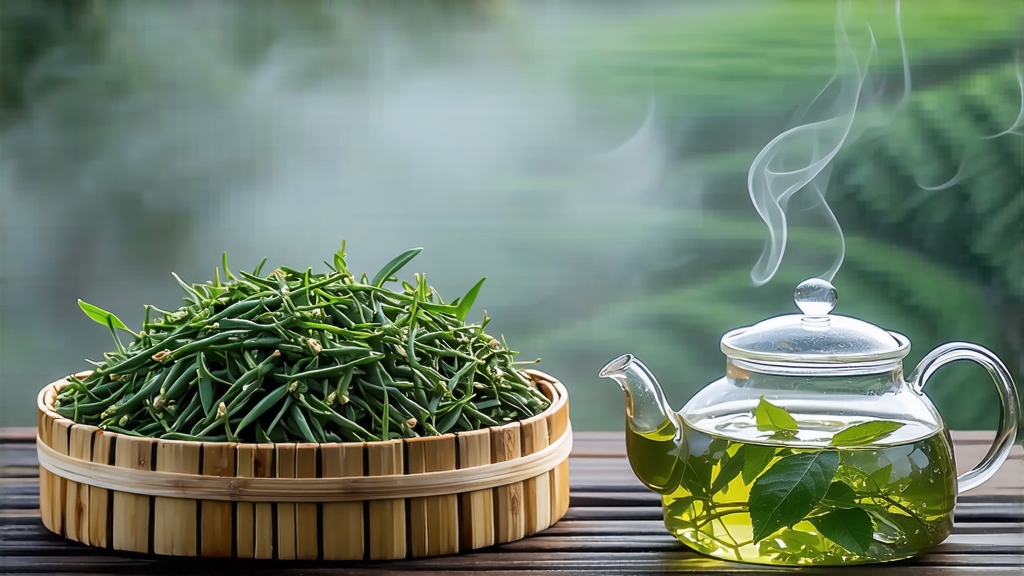
Biluochun, whose name translates literally to “Green Snail Spring,” is one of China’s ten most celebrated teas, yet it remains a delicate secret outside serious tea circles. Produced only in a micro-zone straddling Lake Tai and the Dongting mountains of Jiangsu, this tea carries within its tightly spiraled leaves the perfume of apricot blossoms, the sweetness of lake air, and six centuries of imperial lore. To understand Biluochun is to listen to a soft-voiced story of terroir, craftsmanship, and Chinese aesthetics that favor subtlety over spectacle.
Historical whispers place the tea’s birth during the late Yuan dynasty, when monks in the Dongting hills noticed that tea bushes growing intermingled with peach, plum, and apricot trees yielded an unusually fragrant leaf. The fruits lent their pollen to the nascent buds, and the lake’s morning mist acted as a natural shade cloth, slowing photosynthesis and concentrating amino acids. By the Ming era the tea, then called “Xia Sha Ren Xiang” (literally “Scary-fragrant”), had already entered the imperial tribute list. The Kangxi Emperor, touring the south in 1699, found the name inelegant and rechristened it Biluochun, evoking the snail-like curl of the finished leaf and the season of its picking.
Strictly speaking, only leaf plucked within a 12-kilometer radius of Dongting’s East and West mountains can bear the name. Within this radius two genetic cultivars dominate: the local “Dongting small-leaf” and the more recent “Fuding Dabaicha” introduced to increase yield. Purists prefer the former for its lower tannin and higher floral lactones. The harvest window opens around Grain Rain (mid-April) and closes before May Day; any later and the buds lengthen, the spirals loosen, and the fragrance thins.
Plucking follows a ruthless standard: one bud plus an unfolding leaf no longer than 2.5 cm, picked at dawn while the dew still shields the leaf from bruising. A skilled picker fills only 250 g per hour, and it takes sixty thousand such sets to make one kilogram of finished tea. The crop is never stored overnight; oxidation waits for no one.
The craft sequence—killing green, rolling, and drying—must be finished within four hours. First the leaves are tumble-panned in woks heated to 180 °C for three to four minutes. The high temperature deactivates polyphenol oxidase, locking in the jade color, but the tea master’s wrist must flick the leaves in a figure-eight motion so that they kiss the metal without scorching. Next comes the unique “rub-spiral” step: the still-warm leaves are cupped in a cotton cloth and rolled against the bamboo table with alternating palm pressure. Done correctly, the leaf cell walls rupture just enough to release sap that acts as a natural glue, tightening the spiral. Finally the temperature is dropped to 70 °C for a slow 20-minute bake that reduces moisture to 5 %. The entire choreography is guided by aroma: fresh cut grass signals under-killing, boiled corn means over-killing, and the ideal is a whisper of white peach.
To brew Biluochun Western-style is to miss its kinetic beauty. Instead, use a tall cylindrical glass of 250 ml. Pre-warm the vessel, then drop 3 g of tea onto the bottom. Pour 80 °C water from a height of 10 cm so that the hydraulic tumbling awakens the spirals. Within 30 seconds the leaves begin their underwater ballet, unfurling from tight snails into miniature green swords while releasing silvery hairs that drift like plankton. The first infusion, at 45 seconds, offers a pale champagne liquor with a nose of freesia and steamed edamame. The second, at 20 seconds, deepens into white peach and lake minerality. By the third, a soft creaminess emerges, reminiscent of fresh mozzarella. Stop at the fourth; beyond this the leaf is spent and the dialogue fades.
Professional cupping judges look for four markers: aroma purity, liquor brightness, lingering sweetness, and “downy uniformity.” Place 5 g in a lidded gaiwan, flash-infuse for five seconds, and inhale the lid’s underside; the scent should evoke a mountain meadow after rain. Next, inspect the wet leaf: every piece should be olive green with an intact tip, and the serrated edges must curl inward like a snail shell—any red edge bet